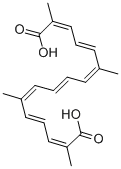Chemical Properties
True saffron is native to Asia Minor and southern Europe. Several varieties of C. sativus L. are known and cultivated in various countries (e.g., France, Spain, Turkey, Greece and Italy). The varieties C. sativus thomasii Ten and C. orsini Parl. are commonly cultivated in Italy. This herbaceous plant is approximately 30 cm (12 in.) tall, has bulbous roots usually branched by smaller fibrous roots, an erect, white, thin scape terminated by purple inflorescences and three red-orange stigmas. The mature stigmas are collected during a short blooming season to produce the spice saffron. Saffron has a sweet, spicy, floral odor with a fatty, herbaceous undertone and a slightly bitter taste. For coloring purposes, the less expensive dried flowers of the American or Mexican saffron (Carthamus tinctorius L., family Compositae) are used in lieu of saffron. However, these varieties have a scarcely perceptible flavor.
Chemical Properties
Red and yellow fibers
Occurrence
Saffron is found in Europe and Asia.
Uses
Saffron is a spice obtained from the dried stigmas of the fall-flower-
ing crocus sativus l. the flower stigma is of intense yellow color. it
has a powerful, somewhat bitter aroma. it is used in breads, fish,
chicken, sauces, and rice dishes.
Definition
Extractives and their physically modified derivatives. Crocus sativus, Iridaceae.
Composition
The dried stigmas contain picrocrocin, crocin, vitamins B and B2 and a small amount of essential oil (ca 0.30%) that is either solvent-extracted or sometimes steam-distilled for specific uses only. Crocin is a mixture of glycosides. The presence of 2,2,6-trimethyl-4,6 cyclohexidienal causes the characteristic spicy, warm odor of the dried product and tinctures; crocin yields the characteristic, bright orange-yellow color.
Biological Activity
Saffron is a crude source of the carotenoid antioxidants crocein and crocetin, as well as other carotenoids and monoterpene aldehydes. Saffron has been studied for use as an anticancer and chemopreventive agent and for its effects on antioxidant defense system pathways. A study in mice reported treatment with saffron reduced lipid peroxidation and caspase-3 activity, while increasing total brain antioxidant activity.

